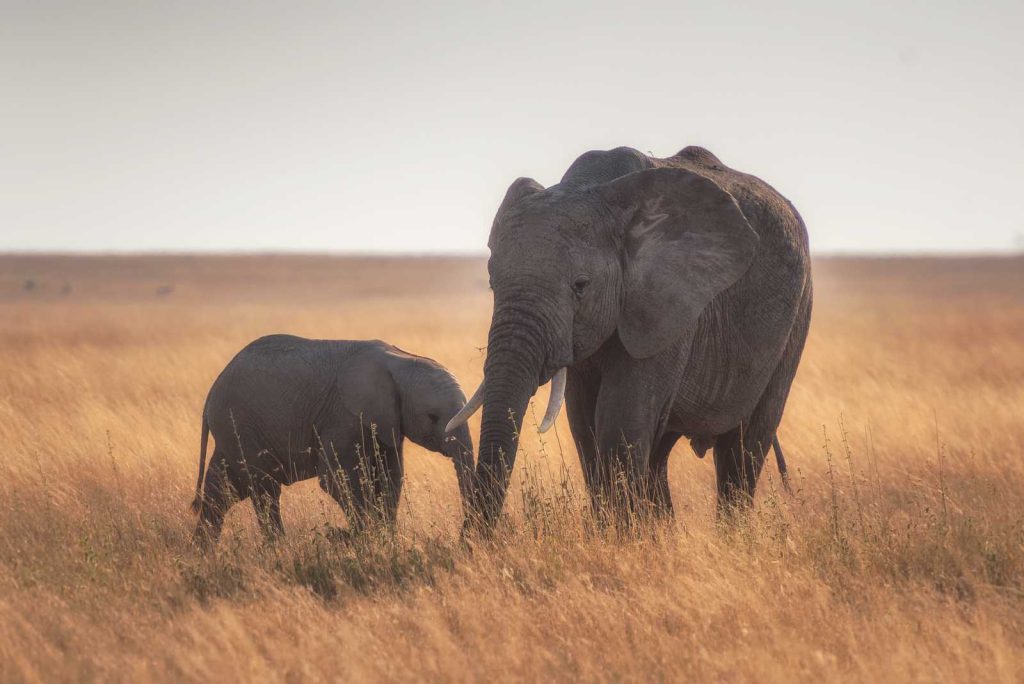TANZANIA DESTINATIONS
TARANGIRE NATIONAL PARK
Highlights
Tarangire National Park has some of the highest elephant population density in Tanzania, and its sparse vegetation, strewn with baobab and acacia trees, makes it a beautiful and distinct place to visit. Tarangire is a popular stop for people traveling through the northern safari circuit on their way to Ngorongoro and the Serengeti. It is only a few hours drive from Arusha. The park is divided into two game-controlled areas, and the wildlife is free to roam throughout.
Thousands of gazelles, wildebeests, zebras, and giraffes migrate to Tarangire National Park’s scrub plains before the rains, where the last grazing land remains. Tarangire provides unrivaled game viewing, and elephants abound during the dry season. Pachyderm families forage around the ancient trunks of baobab trees and strip acacia bark from thorn trees for their afternoon meal. Tarangire is a memorable stopover because of the breathtaking views of the Maasai Steppe and the mountains in the south.
It’s also a quite large the national park and covers an area of approximately 2,850 square kilometers (1,100 square miles.) Tarangire National Park derived its name from the long serving river that crosses the park in the middle called the ‘Tarangire River’. The river acts as the primary source of water for wildlife in the park, which is also one of the reasons of the large variety in the parks ecosystem.
In the park you might encounter good numbers of wildebeest and zebra as well as giraffe, buffalo, Thompson’s gazelle, greater and lesser kudu, eland, leopard and cheetah. It is also the only place in Tanzania where the oryx and gerenuk are regularly spotted
Tarangire is also home to nearly 500 species of birds. Among which the most famous are the lovebirds that are yellow collared, Kori bustard, the stocking-thighed ostrich, the shy starlings are in plenty and widespread in Tanzania.
Wildlife
Witness a lot of migratory movement of elephants joined with other animals with greater Tarangire ecosystem. Many chances to explore plenty of wildlife like zebras, searching for underground streams in the dry river beds, flocks of up to about 300 elephants and many more. Enjoy spotting a large batch of colorful and exclusive bird species.
Tarangire River
The river is fed by seasonal sand rivers originating to the East and South-eastern parts of the park. It flows northward along the park and empties into Lake Burunge. Within the park, the river is linked to/with Silale, Gurusi and Larmakau swamps.
It is undoubtedly that Tarangire River with its associated permanent swamps serves as critical dry season water sources for thousands of migratory animals in dry seasons, thus offering a fantastic game drive experience.
Time to visit Tarangire
The best time to visit Tarangire National Park is during the dry season, from June to October. During this period, wildlife is concentrated around the Tarangire River, the park’s main water source, making it easier to spot large herds of elephants, wildebeest, zebra, and other animals. The dry season also offers better road conditions and fewer mosquitoes. However, the wet season, from November to May, provides lush green landscapes, fewer tourists, and excellent birdwatching, although wildlife is more dispersed

